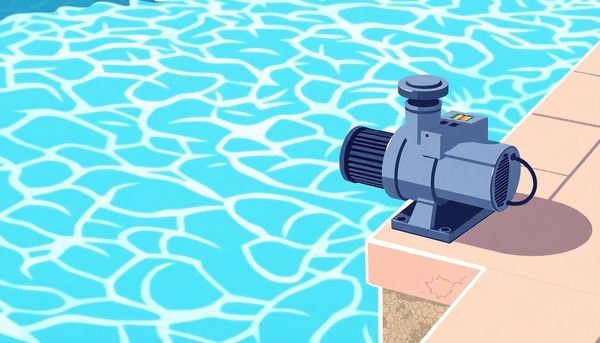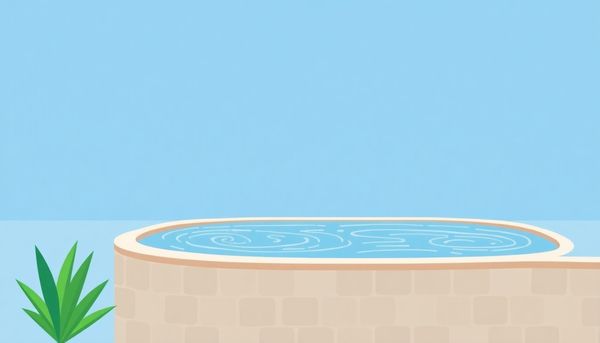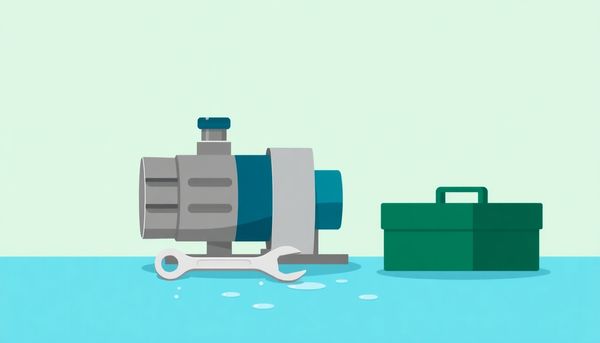How to Prime Your Pool Pump: A Simple Guide for Crystal Clear Water
June 21th, 2024
June 21th, 2024
A backyard pool can be the crown jewel of any home, offering a refreshing escape during the sweltering days of summer. However, the charm of a personal oasis often comes with its own set of maintenance tasks. One such task is ensuring that your pool pump is primed and ready for action. Without a properly primed pump, the water circulation can falter, leaving your pool less than pristine.
I remember a summer not too long ago when my own pool took on a slightly swampy hue, all because I neglected to prime the pump. That was a lesson learned the hard way, but it inspired a deep dive into the world of pool care. Priming a pool pump might sound like a daunting task, especially if you're new to pool maintenance, but breaking it down into simple steps can make it manageable.
The process, while technical, becomes straightforward with the right guidance. It's not just about keeping the water clear; it's about safeguarding the equipment and ensuring the longevity of your pool system. Each step is crafted to make sure you’re not just fixing a problem temporarily, but setting up your pool for long-term success. Whether you're a seasoned pool owner or a beginner dipping a toe into pool maintenance, learning how to prime a pool pump can save you time, money, and a lot of headaches. Let's explore how to keep your pool pump primed in four uncomplicated steps, ensuring your pool remains a sparkling centerpiece.

In the realm of pool maintenance, there's a silent hero that often gets taken for granted: the pool pump. Its role surpasses mere functionality, acting as the heart of your pool's circulatory system. Without it, your pool is like a stagnant pond, quickly collecting debris and becoming a breeding ground for algae. The consequences of neglecting this vital piece of equipment are as costly as they are inconvenient. Repairs can be exorbitant and a total replacement even more so, not to mention the down time for your pool.
A pump that’s not properly primed is at risk for damage, mainly due to overheating. As it runs dry, the motor generates friction, escalating into a meltdown of seals and potential PVC pipe damage. This is not just a theoretical risk; it’s a scenario I faced one spring when I hastily reopened my pool, overlooking the crucial step of priming. The result was a hefty repair bill that could've been avoided had I taken a few simple steps.
Understanding your pool pump's needs is akin to knowing your car’s oil requirements—fundamental for smooth operation. Always ensure the pump is filled with water before starting it. Keep an eye out for air leaks, and regularly check seals and fittings. Remember, a little diligence today prevents major headaches tomorrow. By prioritizing the health of your pump, you preserve the joy and relaxation your pool promises.
To truly appreciate the art of pool maintenance, one must understand the significance of priming the pool pump. It's not just a task—it's a safeguard against costly repairs and pool downtime. Opening up your pool for the season can be as exciting as unwrapping a gift, but there's a crucial step that can easily be overlooked: ensuring the pump is properly primed.
Start by removing the pump lid and inspecting the inside. A dry pump housing is a clear sign that priming is needed. With the drain plugs securely in place, grab your trusty garden hose and fill the pump housing with water. This isn't just a splash-and-dash affair; let the water run for a solid two minutes. This process allows water to creep into the pipes, setting the stage for the pump to create the suction it needs.
Replace the lid, flip the switch, and listen for the reassuring gurgling as the pump awakens. It might take a moment, but patience is key. Soon, you'll witness water filling the housing, signaling a job well done.
In some cases, stubborn air pockets may require a couple of attempts before getting it right. So don't stress if you need to try again. The goal is a smooth, uninterrupted flow of water that ensures your pool remains a clean and inviting oasis. With practice, priming your pool pump becomes second nature, keeping your pool in top condition all season long.
Understanding the intricacies of water flow is akin to knowing your kitchen faucet; turn the wrong way and you might end up with a mess. Just like a faucet, your pool pump thrives on smooth, uninterrupted water flow. Ensuring the pump has a steady stream of water involves more than just filling it up once and hoping for the best.
First, consider the positioning of your pool’s water level. If you've ever filled a bathtub, you know the importance of having enough water to keep things moving. The same rule applies here. The skimmer and return jets should be open and unobstructed, allowing water to freely travel into the pump. If the water level is too low, the pump may struggle to maintain suction, leading to potential overheating.
Next, check for any blockages or debris. Imagine breathing through a straw; even a small piece of paper can disrupt the flow. In the pool world, leaves or clogs in the skimmer basket can create similar resistance. Regularly inspect these areas and clear out any hindrances.
Lastly, it’s beneficial to occasionally open the air relief valve on your pool filter. This simple act can release trapped air, ensuring water moves efficiently through the system. Much like burping a baby after feeding, this step helps keep your pump happy and operational. So, with these measures, you can guarantee your pool pump remains in peak condition, ready to keep your oasis pristine.
Air blockages can be the silent culprits that sabotage your pool pump's performance. This sneaky issue often arises when air sneaks into the system, disrupting the constant water flow that your pump relies on to function efficiently. If left unchecked, air pockets can cause the pump to run dry, leading to overheating and eventually costly damage. Addressing this problem requires a keen understanding of where air can infiltrate and how to prevent it.
A common culprit is loose fittings, which can allow air to slip into the system. Regularly inspect all connections, including pump housing lids and union fittings, to ensure they are tight and secure. A simple twist of a wrench can make a world of difference. Moreover, check for any visible cracks or wear in the plumbing, as these can also be entry points for air.
Another preventive measure is to maintain an adequate water level in your pool. When the water level dips too low, the skimmer can start drawing in air instead of water, leading to those dreaded air pockets. During periods of heavy use or particularly hot weather, keep an eye on the water level to ensure it stays above the skimmer intake.
Also, remember to clean out your pump basket regularly. A clogged basket can reduce water flow and cause the pump to lose prime, increasing the risk of air entering the system. By taking these simple yet effective steps, you can shield your pump from air blockages and keep your pool running smoothly.

Mastering the care of your pool pump is akin to looking after your car's engine. It's the unsung hero working behind the scenes, ensuring every swim is as refreshing as the last. Yet, despite its importance, it's often overlooked until something goes awry. Understanding the intricacies of its upkeep can save you from hefty expenses and mid-summer swim disappointments.
Start by routinely checking the pump for any signs of wear or damage. I recall a neighbor who faced an unexpected pool shutdown during a heatwave because of a small crack that went unnoticed. Regular inspections can catch these issues before they escalate. Also, ensure the pump environment is clear of debris and leaves, which can obstruct airflow and cause overheating—an essential routine, especially after windy days.
Maintaining the correct water level in your pool is another crucial aspect. A drop below the skimmer's level can lead to air entering the pump, causing it to run dry and overheat—which, as we've mentioned, spells trouble. My friend Sarah once spent an entire weekend trying to figure out why her pump wouldn't prime, only to find the water barely skimming the required level.
Finally, make a habit of removing the pump lid and checking for trapped air. This simple step can prevent the dreaded overheating spiral. Think of pump care as part of a larger symphony of pool maintenance—each task, no matter how small, contributing to a harmonious and hassle-free pool experience.
In the realm of pool care, there's a little secret that seasoned pool owners know well: a pool pump must be primed to breathe life into your pool's system. Think of the pool pump as the heart that keeps water circulating. Without water, it’s just a ticking time bomb of impending issues. I remember the first time I skipped this step; the pump sounded like an ancient car struggling to start, and it was a costly lesson learned.
To prime a pool pump, begin by ensuring all valves are in the correct positions, allowing water to flow freely. Next, remove the pump lid and take a peek inside; it should be wet, not dry. If it's been sitting idle, chances are it needs some hydration. Use a garden hose to fill the pump housing generously with water. The trick is to let it run long enough—two minutes usually does the job—to ensure the pipes connected to the pump are also filled.
When you're ready, secure the lid back onto the pump. Then, confidently turn the pump on, watching and listening as water begins its journey through the system. A bit of sputtering is normal, but soon enough, you’ll see the pump housing fill with water, signaling that it’s primed and ready. It's a simple act that saves time, effort, and potentially a small fortune in repairs. Trust me, your pool—and your wallet—will thank you.
Understanding how to prime a pool pump effectively is a crucial step in safeguarding your pool equipment from damage. The pump serves as the heart of your pool's circulation, and like any heart, it drifts into trouble when neglected. If it doesn't have water coursing through it, friction and heat build up, potentially leading to a cascade of costly repairs.
Picture this scenario: a pump running dry can result in the motor overheating. As it heats up, the seal inside the pump begins to melt, which can then lead to damage in the surrounding PVC pipes, like a domino effect. A friend of mine once ignored the low water level in her pool, thinking it was just a minor oversight. Soon enough, her pump was buzzing loudly—a telltale sign something was wrong. By the time she checked, the damage was done, and she was staring at a hefty repair bill.
To prevent such mishaps, always ensure your pump is correctly primed. Start by removing any plugs from skimmers or return jets. Check the pump's interior; if dry, use a garden hose to fill it with water. This simple act not only primes the pump but also prevents it from running dry and overheating. By taking these precautions, you extend the life of your pool equipment and avoid unnecessary expenses. It's a bit like giving your pool's heart the care it deserves, ensuring it continues to beat seamlessly throughout the season.
Ensuring proper water circulation in your pool is like crafting the perfect cup of coffee—it's all about balance and consistency. Without it, you're left with a murky situation that nobody wants to dive into. The pump, acting as the heart of this system, must always be kept in working order, not just to save you from expensive repairs, but to maintain the crystal clarity of your pool.
On a sunny weekend morning, I once found myself dealing with a stubborn pump that refused to cooperate. The absence of circulation had left the pool looking more like a pond, with leaves and debris lazily floating on the surface. It was a wake-up call that highlighted the necessity of regular maintenance and vigilance.
Begin by ensuring all your valves and connections are airtight; even a tiny leak can invite unwanted air into the system, disrupting the flow. Next, make sure your skimmers and return jets are free from obstructions. These little gateways play a crucial role in moving water efficiently through the pump and filter.
When I pre-filled my pump, I realized the importance of patience. Letting water seep into every nook and cranny of the system ensures that air pockets don't stand a chance. After replacing the lid and turning the pump on, I watched as the water began to flow smoothly once again, a tiny victory that reaffirmed the significance of keeping things fluid. Remember, a well-circulated pool isn't just appealing; it’s a testament to proactive care.

In the realm of pool maintenance, ensuring proper water circulation is akin to safeguarding the heartbeat of your aquatic sanctuary. Without this continuous flow, pools transform from refreshing havens into murky, stagnant ponds. You might recall that time when you skipped a few days of maintenance, only to find the water looking less like a pristine oasis and more like a forgotten pond. The culprit? Poor water circulation, often due to an improperly primed pump.
Start by ensuring that all skimmers and return jets are unobstructed, allowing water to freely flow into the system. Remove any debris, like leaves or stray toys, that might have sneaked in during the night. A clear path for water ensures a smooth start, allowing the pump to do its job effectively. Once the path is clear, next comes the crucial step of filling the pump housing with water. This pre-filling prevents the pump from running dry, which can lead to overheating and eventual damage.
After replacing the lid securely, switch on the pump and listen for that reassuring hum. A few gurgles at the start are normal; it's simply the system adjusting, pushing out air pockets until it achieves a steady flow. However, if you're met with silence or persistent sputtering, it might mean revisiting the steps to ensure no air is trapped within the system. The rhythm of your pool’s operation depends heavily on these initial actions to sustain its health and functionality.
A pool with good water circulation is a pool that’s inviting and ready for a swim at a moment’s notice, so take these steps seriously. Once everything's in place, you can relax, knowing your pump is primed and your pool is prepped for endless enjoyment.
There's a certain satisfaction in knowing that a small yet significant task can save you hundreds of dollars and keep your pool in stellar condition. Priming your pool pump is one of those tasks. It’s like making sure the engine of a car is well-oiled before a long road trip. When a pump sits dry, it’s as if the heart of your pool's circulation system is gasping for breath, and that’s not where you want to find yourself just when the swimming season kicks off.
Start by ensuring that the pool's water level is adequate. This seemingly minor step is crucial because without enough water, the pump can't create the necessary suction to function efficiently. Next, remove the pump lid and take a peek inside. It should be wet in there; if not, it’s time to grab a garden hose. Pour water into the pump housing for a good couple of minutes. This not only fills the housing but also encourages water to seep into the pipes, setting the stage for effective suction.
Once the housing is full, replace the lid snugly. Flip the switch and listen to the comforting hum as water circulates through the system. If the pump stutters, don’t stress—stop, add more water, and try again. This small ritual is your pool’s lifeline, preventing costly repairs and ensuring that your aquatic oasis remains a crystal-clear retreat.
In the realm of pool care, few tasks rival the importance of preventing pump overheating. Neglecting this could mean halting your pool's functionality and diving into costly repairs. Picture the pump as the relentless engine of your pool—a powerhouse that thrives on a steady stream of water to stay cool and operational. Without this lifeline, it’s like running a marathon with no water, where friction builds, heat surges, and components succumb to stress.
To safeguard your pump from such a fate, vigilance is key. Regularly check water levels, especially during those sweltering summer months when evaporation is a sneaky culprit. A swift glance at the skimmer and return jets ensures that water flows unobstructed, protecting the pump from running dry. And don’t forget the seals; these unsung heroes keep air at bay and water where it should be. When they wear out, it’s an open invitation for air to sneak in, disrupting the pump’s smooth operation.
From personal experience, a simple weekly routine of checking and cleaning can stave off many headaches. I once grappled with a sudden pump shutdown during a family barbecue. Lesson learned: keeping the pump primed is as essential as the burgers on the grill. By staying proactive, you not only extend the pump’s life but also ensure your pool remains a refreshing oasis all season long. So, give your pump the attention it deserves, and it will reward you with endless days of crystal-clear water.
The soft hum of a well-functioning pool pump is like a comforting lullaby for any pool owner. However, when air sneaks its way into the system, that harmony is disrupted, leading to a cacophony of potential problems. Air leaks are notorious culprits, often lurking in the shadows until they cause significant hiccups in your pool's circulation. Before you even think about priming, take a moment to play detective and inspect for air leaks.
First, consider the pump lid. A loose or poorly sealing lid can easily invite air into the system. Make sure it’s screwed on tightly and that the O-ring is intact and lubricated. This small rubber ring plays a crucial role in keeping your pump airtight. A dry or cracked O-ring will only lead to trouble, so replace it if necessary.
Next, turn your attention to the plumbing connections. These junctions can become loose over time due to vibrations from the pump's operation. Check each connection, using a wrench to gently tighten them if needed. Be cautious, though—overtightening could cause more harm than good.
If suspicions persist, a tried-and-true method is to use a soapy water solution. Apply it around the suspected areas and watch for bubbles; they’re tell-tale signs of escaping air. Once you’ve confidently eliminated air leaks as a threat, you’re one step closer to ensuring your pump primes effortlessly, keeping your pool pristine and problem-free.

The pool pump is the unsung hero of pool maintenance, tirelessly ensuring water circulates, stays clean, and remains inviting for those sun-drenched afternoons by the poolside. Yet, it's easy to overlook the significance of priming this vital component, especially when everything seems to be running smoothly.
I learned this the hard way one summer when I noticed a strange grinding noise from the pump. Ignoring it seemed easier until the pump completely shut down, transforming my backyard oasis into a stagnant pond. A chat with a pool technician revealed that a simple priming could have prevented the costly repair. The process of priming, essentially filling the pump with water to eliminate air pockets, is pivotal in avoiding unnecessary friction and overheating.
When air sneaks into the system, it disrupts the pump’s function, potentially causing seals to melt and pipes to warp. Turning on a dry pump is like running a car engine without oil—devastating and avoidable. By regularly checking water levels and ensuring the pump is primed, you’re safeguarding against such expensive mishaps.
A few minutes spent on proper pump maintenance can save you from a hefty bill and the heartache of a dormant pool. Priming is not just a step; it’s a shield against the unwanted surprise of pump failure. Keep your pool pump primed, and your summer bliss uninterrupted.
Ensuring that your pool pump is primed properly is crucial in maintaining your pool's health and preventing costly damage. Let’s say you’ve just finished a long winter, and your pool’s been dormant. As you prepare to restart your pool, the pump awaits its annual revival, and priming it is your first step.
Begin by ensuring all the return jets and skimmer plugs are removed. This allows water to flow unhindered into the pump. Open the pump's lid and inspect the interior. If it appears dry, grab a garden hose and let the water flow into the pump housing for about two minutes. This pre-filling step is essential as it helps the water seep into the connecting pipes, establishing the necessary suction for the pump to function efficiently.
Once you’ve added sufficient water, securely replace the lid. Switch the pump on, and you might hear some initial gurgling or sputtering. Don’t worry—this is just the pump working air out of the system. Watch for the housing to fill completely with water, signaling that the pump is primed and ready.
If, however, the pump doesn’t prime on the first attempt, turn it off and add more water, repeating the process. Persistent issues might indicate a blockage or leak, so inspect the pump for any visible cracks or damages. If troubleshooting doesn't resolve the problem, consider professional help to avoid further complications. In the end, a well-primed pump keeps your pool’s heart beating strong, ensuring clear, circulating water throughout the swimming season.
To keep that pool pump humming without a hitch, addressing potential overheating issues is paramount. An overheated pump not only risks expensive repairs but also disrupts your pool enjoyment. The heat issue stems from the pump's requirement for constant water flow—without it, friction heats up the motor. This, in turn, can cause seals to melt and damage to nearby PVC pipes.
Consider this: my neighbor Jenny had a nasty surprise last summer. She left her pool idle for a few months during an unexpected travel stint. Upon her return, she flipped the switch without checking the pump, and within minutes, the motor was smoking. A costly replacement ensued, and her family picnic plans were submerged along with her budget.
To sidestep such misfortunes, ensure that air pockets are cleared from your plumbing system before starting the pump. If the pump's housing is dry, pre-fill it with a garden hose. This simple act can prevent the internal components from reaching dangerous temperatures. Keep an eye on your water level too, as a sudden drop might leave the pump dry, leading to overheating.
Priming your pump effectively is a small but significant step. It not only extends the life of your equipment but also ensures you’re never caught off guard by unexpected expenses. It’s a straightforward task that pays off in peace of mind and uninterrupted pool fun.
Water circulation is the unsung hero of a healthy pool, quietly ensuring everything runs smoothly. My neighbor once disregarded this crucial step, thinking her pool would hold out just fine. Spoiler: it didn't. The pump struggled, algae bloomed, and her summer oasis quickly turned into a green swamp. Now, she never skips priming her pool pump.
To maintain this essential water flow, always start by making sure your pool’s water level is optimal. A sudden reduction in water can lead to air entering the system, disrupting circulation. Keep an eye on that skimmer basket too. It's a common culprit for blockages that hinder water movement, causing your pump to work overtime and risking burnout.
When positing a fresh season or after hefty maintenance, remember to fill the pump housing with water. A simple garden hose can be your best ally here. Let it run for a couple of minutes directly into the pump housing, ensuring the pump is ready to suction effectively.
Another trick: introduce water directly into the skimmer. This might help dislodge air bubbles hiding in the lines. Keep vigilance for leaks, especially if priming repeatedly fails. Even a minuscule crack can become a massive headache.
In the dance of pool maintenance, water circulation plays the lead role. Ensuring your pump is properly primed not only keeps water clear but also safeguards the longevity of your pool’s integral parts. So next summer, when everyone else is fiddling with murky water, you'll be lounging poolside, stress-free.
In the realm of pool maintenance, priming your pool pump can be likened to ensuring your car engine has enough oil. Neglect it, and the consequences can spiral from minor hiccups to major disasters. One vivid memory comes to mind: a neighbor once neglected this simple ritual, and his pool turned from a sparkling oasis into a murky swamp within days. While costly repairs loomed over him, the lesson was clear—never underestimate the power of priming.
First, get familiar with your pump setup. Imagine it as the heart of your pool, where water must flow seamlessly to keep everything in motion. Begin by ensuring that all skimmer and return jet plugs are removed. These plugs can act like bottlenecks, preventing water from reaching the pump effectively. Next, the pump lid must come off for a quick inspection—dry as a desert means it’s in desperate need of water.
With a trusty garden hose in hand, fill the pump housing—this primes the system by allowing water to trickle into the connected pipes. Let it flow for a solid two minutes, giving the system a chance to hydrate and create the necessary suction. Replace the lid securely, switch on the pump, and listen for the telltale gurgles that signal water is moving through. Once the housing brims with water, you've successfully primed your pool pump, ready to bask in the clarity of your pool.
Ensuring your pool pump remains undamaged is akin to giving your pool a healthy heartbeat. Think of your pool pump as the engine that keeps everything running smoothly. Yet, many pool owners overlook the importance of preventing damage to this vital piece of equipment. A small oversight, like running the pump dry, can quickly escalate into costly repairs or replacements. When a pump operates without water, it risks overheating, which can melt seals and damage PVC pipes, leading to a premature breakdown.
Understanding the nuances of your pool pump's needs is essential. For instance, seasonal changes can introduce air into the system, particularly when winterizing your pool. This air must be expelled by priming the pump effectively when you reopen the pool in spring. This isn't merely a routine task—it's a crucial step in safeguarding your investment. Skipping it can leave your pump vulnerable to overheating and potential failure, turning a simple oversight into a major expense.
By regularly checking your pool’s water level and ensuring that the pump is primed, you prevent air pockets from forming, which can block water flow and cause overheating. The process is straightforward but demands attention to detail. A well-primed pump means your pool stays cleaner, your equipment lasts longer, and your summer days remain uninterrupted by unexpected repairs.

This article provided insights into maintaining your pool. Start your pool care journey today!
Want to become a pool maintenance expert? Our free Pool School course covers everything you need to know about pool care. From basic maintenance to advanced troubleshooting, you'll learn how to:
Join over 10,000 pool owners who have already transformed their pool care routine. Get started with our free Pool School course today!